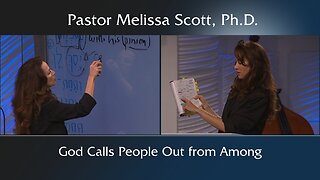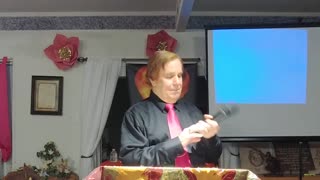Episode 2182: One Time God Questioned God
"One Time God Questioned God '"
We delve into the rich and profound mysteries of our Catholic faith. Today, we are exploring one of the most poignant and perplexing moments in the Gospels: Christ’s cry from the cross, "My God, My God, why have You forsaken Me?" As Catholics, this moment invites us into a deep contemplation of the mystery of Christ’s Passion and the profound theological implications of God questioning God.
To understand the significance of Christ’s words, we must first acknowledge the context in which they were spoken. Jesus, hanging on the cross, uttered these words in Aramaic: "Eli, Eli, lama sabachthani?" This moment is recorded in both Matthew 27:46 and Mark 15:34. It’s a direct quotation from Psalm 22, a psalm of David that begins in despair but ends in hope and triumph.
The Human Experience of Christ
One of the key aspects of our faith is the mystery of the Incarnation Jesus Christ as fully God and fully man. In His humanity, Jesus experienced the full range of human emotions and sufferings. On the cross, He bore the weight of all our sins and the resulting separation from God that sin causes.
When Jesus cried out, "My God, My God, why have You forsaken Me?" He was expressing the deep anguish and abandonment He felt in His humanity. This was not an expression of doubt in the Father’s love or presence, but a reflection of the real suffering He endured for our sake. It’s crucial to remember that Jesus, though fully divine, did not shield Himself from the human experience of suffering and abandonment.
Theological Implications – God Questioning God
To begin, we must understand that the phrase "God questioning God" touches on the very essence of the Trinitarian mystery. The Holy Trinity – Father, Son, and Holy Spirit – is the core of our Christian faith, a communion of three distinct persons in one divine essence. When Jesus, the Son of God, cries out to the Father, it invites us into a profound contemplation of the internal dynamics of the Trinity, particularly as it pertains to the Incarnation and the Passion of Christ.
1. The Hypostatic Union:
The hypostatic union refers to the theological concept that Jesus Christ is one Person with two natures – fully divine and fully human. This union is inseparable and complete, yet the two natures are distinct. When Jesus, in His humanity, expresses a sense of abandonment on the cross, it does not negate His divinity. Rather, it reveals the depth of His incarnation. If there was any doubt of who Christ was he settles it with that statement. He is part of the trinity but once he became incarnate he was given a human nature. It was that Human nature that made him refer to God the Father in that manner and not as the son of the Trinity.
In His human nature, Jesus experienced suffering, abandonment, and even death. This experience is real and profound. However, His divine nature remains united with the Father and the Holy Spirit. The cry, "My God, My God, why have You forsaken Me?" emanates from His human experience of the weight of sin and separation from God, which He bore on behalf of humanity.
2. The Trinity and the Economy of Salvation:
The economy of salvation refers to God’s plan and actions for the salvation of humanity. The Father, Son, and Holy Spirit are distinct Persons who act in unity within this divine plan. The cry from the cross reveals the intimate and mysterious relationship within the Trinity, particularly in the context of the Incarnation and the Redemption.
Christ’s cry highlights the sacrificial love of the Father and the Son. Every divine act starts with the Father proceeds through the son and is fulfilled by the Holy Spirit. This is why as God the Father sends the Son into the world out of love for humanity (John 3:16). The Son willingly accepts the mission, even unto death. The cry from the cross, then, is a moment of intense relational dynamics within the Trinity a moment where the human experience of Jesus intersects with His divine mission. After his resurrection and ascension the Son has the Holy Spirit fulfill what he proceeded with and that was the accomplishment of mans redemption.
3. The Mystery of Divine Abandonment:
While Jesus’ divine nature was never separated from the Father, His human nature experienced the sense of abandonment that comes from bearing the sins of the world. This moment reflects the ultimate consequence of sin separation from God. Jesus, though sinless, took upon Himself the sins of all humanity.
Theologically, this moment of "divine abandonment" can be seen as the climax of Jesus’ solidarity with humanity. He experiences the depth of human estrangement from God so that He can restore the broken relationship between God and humanity. This is a profound act of love and redemption.
4. Fulfillment of Prophecy and Scriptural Typology:
Christ’s cry is a direct quotation from Psalm 22, a messianic psalm that begins with despair but ends in triumph. By invoking this psalm, Jesus connects His suffering to the fulfillment of Old Testament prophecies. The Psalm, though it starts with a feeling of forsakenness, ultimately proclaims trust in God and ends in victory and praise.
This indicates that Christ’s suffering and sense of abandonment were not the end but part of the divine plan leading to resurrection and redemption. It underscores the belief that God’s purposes, even when shrouded in suffering, are ultimately oriented towards salvation and glory.
5. Theological Reflections from Church Fathers and Doctors:
The Church Fathers and Doctors of the Church have offered profound insights into this mystery. St. Augustine and St. Thomas Aquinas, for example, emphasize the real human experience of Christ while affirming His divine nature. They reflect on how this cry showcases both the depth of His suffering and the mystery of the Trinity.
St. John Paul II, in his reflections on the Passion, highlighted that Christ’s cry from the cross is a profound expression of His solidarity with all who feel abandoned by God. It’s a moment where the mystery of God’s love and the reality of human suffering intersect.
St. Thomas Aquinas and other Church Fathers have reflected on this moment as one of profound mystery. They suggest that while Christ, in His divine nature, was never separated from the Father, in His human nature, He fully experienced the weight of human sin and the sense of abandonment that comes with it. This cry thus becomes a testament to the depth of God’s love for humanity, willing to enter into our suffering to redeem us.
Psalm 22 – From Despair to Hope
Understanding Christ’s cry also requires us to look at Psalm 22 in its entirety. The psalm begins with a cry of desolation but moves towards a declaration of trust in God and ends in praise and hope.
By quoting the opening line of Psalm 22, Jesus was not only expressing His anguish but also pointing to the fulfillment of prophecy and the ultimate victory that would follow His suffering. The psalm speaks of being mocked and scorned, hands and feet being pierced all pointing to the crucifixion. Yet, it culminates in a proclamation of God’s faithfulness and deliverance.
For us Catholics, this is a reminder that in moments of suffering and feeling forsaken, we are called to trust in God’s plan and His ultimate victory. Our suffering, united with Christ’s, has redemptive value.
Conclusion:
As we reflect on Christ’s cry from the cross, "My God, My God, why have You forsaken Me?" we are invited into a deeper understanding of the mystery of our faith. It’s a moment that encapsulates the depth of Christ’s suffering and the profound love of God for humanity.
This cry reminds us of the reality of suffering but also of the hope and redemption that is found in Christ. It challenges us to trust in God’s plan, even when we feel abandoned or in despair, knowing that through Christ, our suffering can be transformed and lead to new life.
Thank you for joining us on this journey into the heart of our faith. Until next time, may God bless you and keep you, and may you always find hope in the love of Christ, who endured all for our salvation.
-
 16:14
16:14
CatholicReboot
26 days ago $0.04 earnedEpisode 2165: Eternal Wisdom from Saints and Scripture
125 -
 11:57
11:57
CatholicReboot
22 days ago $0.05 earnedEpisode 2172: Embracing the Fire of Faith - Nightly Episode
127 -
 1:08:11
1:08:11
ArtBaptist1611
22 days agoThe Firstborn of Every Creature | Pastor Jason Robinson
49 -
 1:24:11
1:24:11
ArtBaptist1611
26 days ago2 Samuel 6 (The Ark of God) | Pastor Jason Robinson
49 -
 4:24
4:24
The Daily Devo by Vince Miller
22 days ago $0.03 earnedNavigating Seasons When God Is Silent | 1 Samuel 3:1
35 -
 14:30
14:30
agodman
21 days agohow the "bachelor" God becomes the married God
35 -
 7:02
7:02
The Daily Devo by Vince Miller
21 days ago4 Principles for Tuning Into God’s Voice | 1 Samuel 3:2-7
361 -
 1:26:55
1:26:55
ArtBaptist1611
22 days agoOverview of 1 Kings | Pastor Jason Robinson
68 -
 1:19
1:19
Pastor Melissa Scott, Ph.D.
22 days agoEphesians 1 - God Calls People Out from Among
191 -
 2:27:31
2:27:31
RevivalFireChurch
22 days agoRevival-Fire Church Worship Live! 05-27-24 Returning Unto God From Our Own Ways In This Hour-Jam4
19